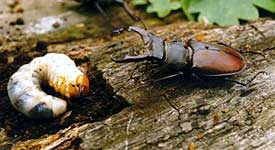THE GREAT STAG HUNT
 This summer, the People’s Trust for Endangered Species (PTES) is putting out a nationwide appeal for members of the public to help with the third of its Great Stag Hunts, a survey it carries out once every four years, to try and map the distribution of stag beetles in Britain. The data can then becompared to the previous surveys (in 2002 and 1998) to give a vital insight into how the species are faring.
This summer, the People’s Trust for Endangered Species (PTES) is putting out a nationwide appeal for members of the public to help with the third of its Great Stag Hunts, a survey it carries out once every four years, to try and map the distribution of stag beetles in Britain. The data can then becompared to the previous surveys (in 2002 and 1998) to give a vital insight into how the species are faring.Experts are concerned that the species’ status may have changed in the past four years. “A number of factors, including changes in gardening practices (leaving less dead wood around and having tidier gardens), local environments and climate, may all have affected stag beetle populations, both at a local and national level” observed Jill Nelson PTES ChiefExcutive.
“We are also particularly concerned that some members of the public are labouring under the misapprehension that stag beetles will attack them or their homes, when in fact they are harmless to both. Consequently, it is essential that we raise awareness of the beetle and gather comprehensive information this year to see just how serious the situation has become.”
The UK’s largest insect, the species is currently listed on Schedule II of the EC Habitats Directive, as it is now very rare or even extinct in much of western Europe. It is known to have become extinct in Latvia and Denmark. In the UK, the beetle is classed as Nationally Scarce. In 1995, the UK Biodiversity Group produced a stag beetle Species Action Plan (SAP) and three years later, the Government placed it on Schedule 5 of the Wildlife & Countryside Act, making it illegal to trade the species without a licence.
The stag beetle is a large beetle so named because of the grossly-oversized mandibles of the male, which look similar to the antlers of a male deer or stag. They are used in courtship displays and to wrestle with other male beetles. The stag beetle has a very long life cycle, lasting at least four years and possibly up to seven. They spend most of their time as larvae living underground and eating rotting wood. “Spotting adult beetles is actually more unusual than you might think,” commented Matt Smith, one of PTES’s beetle experts, “Stag beetles are only in their adult form, above ground, for up to four weeks, during which time they search frantically for a mate in order to breed. This happens between May and August, which is why we run The Great Stag Hunt then.”
More information about the Great Stag Hunt, which runs from the beginning of may to the end of August, can be found on the PTES website at http://www.ptes.org/ and any sightings can be recorded online there.

0 Comments:
Post a Comment
<< Home